1994 BUICK PARK AVENUE recommended oil
[x] Cancel search: recommended oilPage 183 of 324
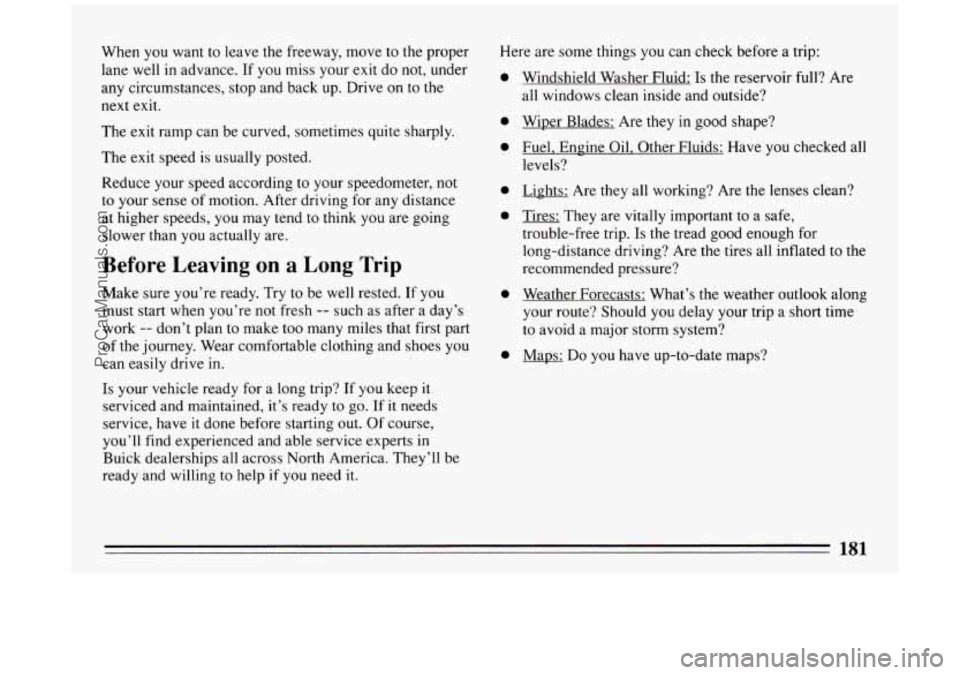
When you want to leave the freeway, move to the proper
lane well
in advance. If you miss your exit do not, under
any circumstances, stop and back up. Drive on to the
next
exit.
The exit ramp can be curved, sometimes quite sharply.
The exit speed
is usually posted.
Reduce your speed according to your speedometer, not
to your sense of motion. After driving for any distance
at higher speeds, you may tend to think you are going
slower than you actually are.
Before Leaving on a Long Trip
Make sure
you’re ready. Try to be well rested. If you
must start when you’re not fresh
-- such as after a day’s
work
-- don’t plan to make too many miles that first part
of the journey. Wear comfortable clothing and shoes you
can easily drive in.
Is your vehicle ready for a long trip? If you keep it
serviced and maintained, it’s ready to go. If it needs
service, have it done before starting out.
Of course,
you’ll find experienced and able service experts in
Buick dealerships all across North America. They’ll be
ready and willing to help
if you need it.
Here are some things you can check before a trip:
0
0
0
0
0
0
0
Windshield Washer Fluid: Is the reservoir full? Are
all windows clean inside and outside?
Wiper Blades: Are they
in good shape?
Fuel, Engine Oil, Other Fluids: Have you checked all
levels?
Lights: Are they all working? Are
the lenses clean?
Tires: They are vitally important
to a safe,
trouble-free trip.
Is the tread good enough for
long-distance driving? Are the tires all inflated to the
recommended pressure?
Weather Forecasts: What’s the weather outlook along
your route? Should
you delay your trip a short time
to avoid a major storm system?
Maps:
Do you have up-to-date maps?
181
ProCarManuals.com
Page 240 of 324
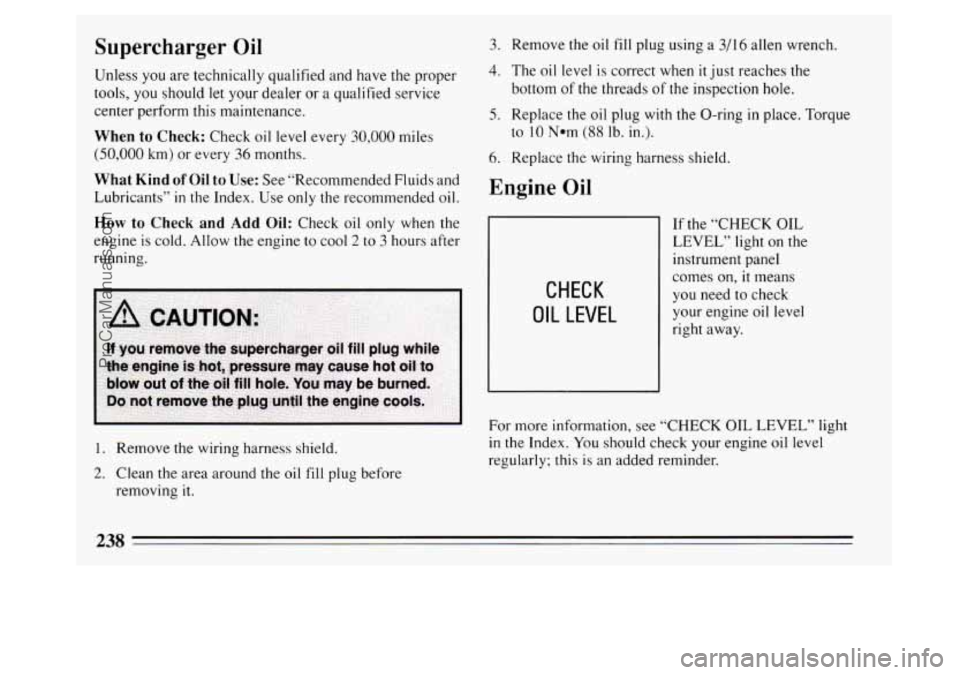
Supercharger Oil
Unless you are technically qualified and have the proper
tools, you should
let your dealer or a qualified service
center perform this maintenance.
When to Check: Check oil level every 30,000 miles
(50,000 km) or every 36 months.
What Kind of Oil to Use: See “Recommended Fluids and
Lubricants”
in the Index. Use only the recommended oil.
How to Check and Add Oil: Check oil only when the
engine is cold. Allow the engine to cool
2 to 3 hours after
running.
1. Remove the wiring harness shield.
2. Clean the area around the oil fill plug before
removing
it.
3. Remove the oil fill plug using a 3/16 allen wrench.
4. The oil level is correct when it just reaches the
bottom
of the threads of the inspection hole.
5. Replace the oil plug with the O-ring in place. Torque
to 10 Nom (88 lb. in.).
6. Replace the wiring harness shield.
Engine Oil
CHECK
OIL LEVEL
If the “CHECK OIL
LEVEL” light on the
instrument panel
comes on,
it means
you need to check
your engine oil level
right away.
For more information, see “CHECK
OIL LEVEL” light
in the Index. You should check your engine oil level
regularly; this is an added reminder.
238
ProCarManuals.com
Page 242 of 324
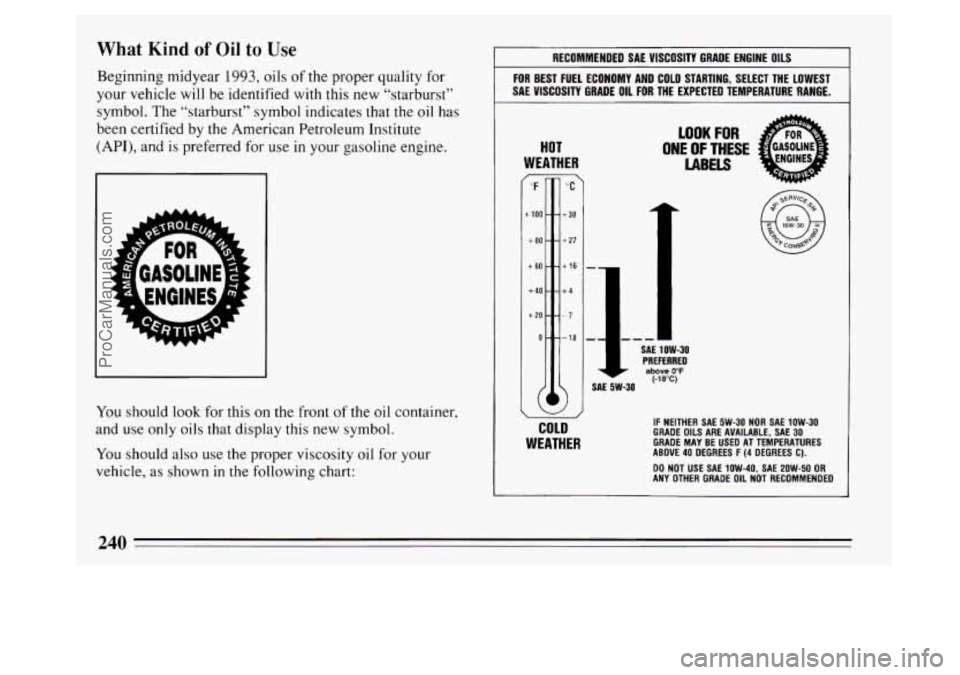
What Kind of Oil to Use
Beginning midyear 1993, oils of the proper quality for
your vehicle
will be identified with this new “starburst”
symbol. The “starburst” symbol indicates that the
oil has
been certified by the American Petroleum Institute
(API), and is preferred for use in your gasoline engine.
You should look for this on the front of the oil container,
and
use only oils that display this new symbol.
You should also use the proper viscosity oil for your
vehicle, as shown
in the following chart:
RECOMMENDED SAE VISCOSITY GRADE ENGINE OILS
FOR BEST FUEL ECONOMY AND COLD STARTING, SELECT THE LOWEST
SAE VISCOSITY GRADE OIL
FOR THE EXPECTED TEMPERATURE RANGE.
HOT
WEATHER
LOOK FOR
ONE OF THESE
LABELS / ‘F %‘ -
+lo0 - - +38
+80--+27
+60--+I6 -
+40--+4
+20 ---7
SAE 1 OW-30 PREFERRED above 0°F (-18°C) SAE 5W-30
a
COLD
WEATHER
IF NEITHER SAE 5W-30 NOR SAE 1OW-30 GRADE OILS ARE AVAILABLE, SAE 30 GRADE MAY BE USED AT TEMPERATURES
ABOVE 40 DEGREES F (4 DEGREES C).
ANY OTHER GRADE OIL NOT RECOMMENDED
DO NOT USE
SAE 1OW-40, SAE 2OW-50 OR
240
ProCarManuals.com
Page 286 of 324
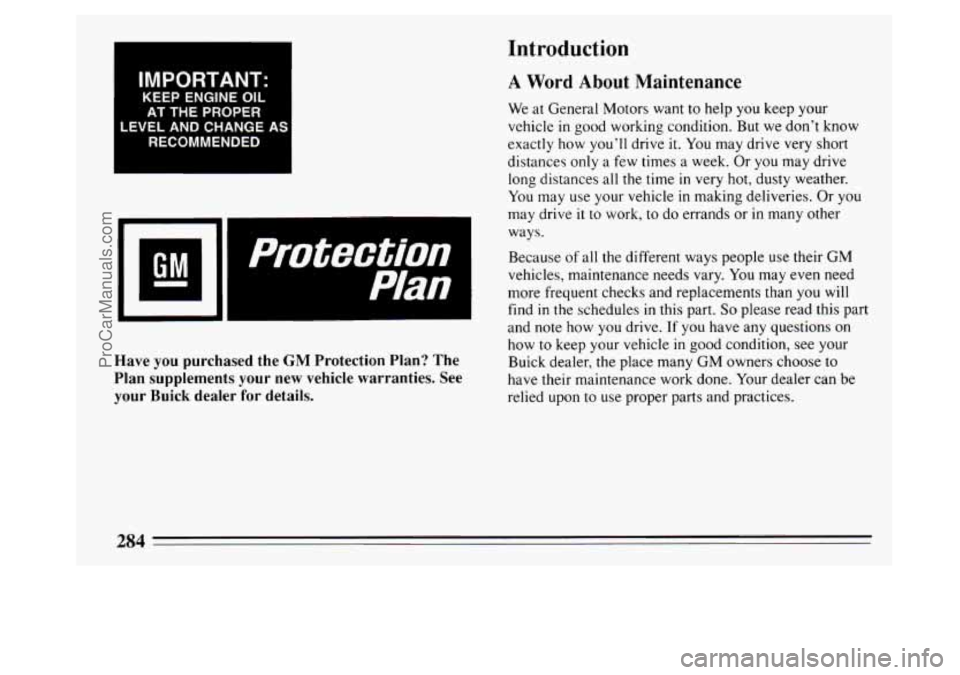
I IMPORTANT: I
KEEP ENGINE OIL
AT THE PROPER
LEVEL AND CHANGE AS
RECOMMENDED
11
protection I
Have you purchased the GM Protection Plan? The
Plan supplements your new vehicle warranties. See
your Buick dealer for details.
Introduction
A Word About Maintenance
We at General Motors want to help you keep your
vehicle in good working condition. But we don’t know
exactly how you’ll drive
it. You may drive very short
distances only a few times a week. Or you may drive
long distances all the time
in very hot, dusty weather.
You
may use your vehicle in making deliveries. Or you
may drive
it to work, to do errands or in many other
ways.
Because
of all the different ways people use their GM
vehicles, maintenance needs vary. You may even need
more frequent checks and replacements than you
will
find in the schedules in this part. So please read this part
and note how you drive.
If you have any questions on
how to keep your vehicle in good condition, see your
Buick dealer,
the place many GM owners choose to
have their maintenance work done. Your dealer can be
relied upon to use proper parts and practices.
284
ProCarManuals.com
Page 295 of 324
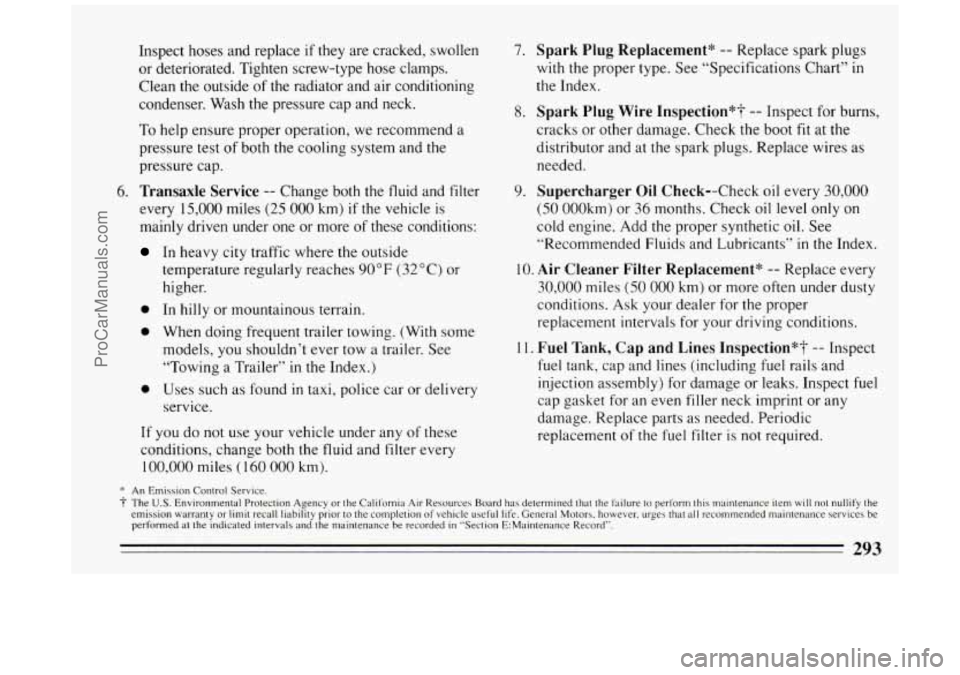
Inspect hoses and replace if they are cracked, swollen
or deteriorated. Tighten screw-type hose clamps.
Clean the outside of the radiator and air conditioning
condenser. Wash the pressure cap and neck.
To help ensure proper operation, we recommend a
pressure test of both the cooling system and the
pressure cap.
6.
Transaxle Service -- Change both the fluid and filter
every
15,000 miles (25 000 km) if the vehicle is
mainly driven under one or more
of these conditions:
In heavy city traffic where the outside
temperature regularly reaches
90°F (32°C) or
higher.
0 In hilly or mountainous terrain.
0 When doing frequent trailer towing. (With some
models, you shouldn’t ever tow a trailer. See
“Towing a Trailer”
in the Index.)
0 Uses such as found in taxi, police car or delivery
service.
If you do not use your vehicle under any of these
conditions, change both the fluid and filter every
100,000 miles ( 160 000 km).
7. Spark Plug Replacement* -- Replace spark plugs
with the proper type. See “Specifications Chart”
in
the Index.
8. Spark Plug Wire Inspection*-f -- Inspect for burns,
cracks or other damage. Check the boot
fit at the
distributor and at the spark plugs. Replace wires as
needed.
9. Supercharger Oil Check--Check oil every 30,000
(50 000km) or 36 months. Check oil level only on
cold engine. Add the proper synthetic oil. See
“Recommended Fluids and Lubricants” in the Index.
10. Air Cleaner Filter Replacement* -- Replace every
30,000 miles (50 000 km) or more often under dusty
conditions. Ask your dealer for the proper
replacement intervals for your driving conditions.
1 1. Fuel Tank, Cap and Lines Inspection*? -- Inspect
fuel tank, cap and lines (including fuel rails and
injection assembly) for damage or leaks. Inspect fuel
cap gasket for an even filler neck imprint or any
damage. Replace parts as needed. Periodic
replacement
of the fuel filter is not required.
* An Emission Control Service.
-f The US. Environmental Protection Agency or the California Air Resources Board has determined that the failure to perform this maintenance item will not nullify the
emission warranty or limit recall liability prior to the completion of vehicle useful life. General Motors. however. urges that all recommended maintenance services be
performed at the indicated intervals and the maintenance be recorded in “Section E:Maintenance Record”.
293
ProCarManuals.com
Page 301 of 324
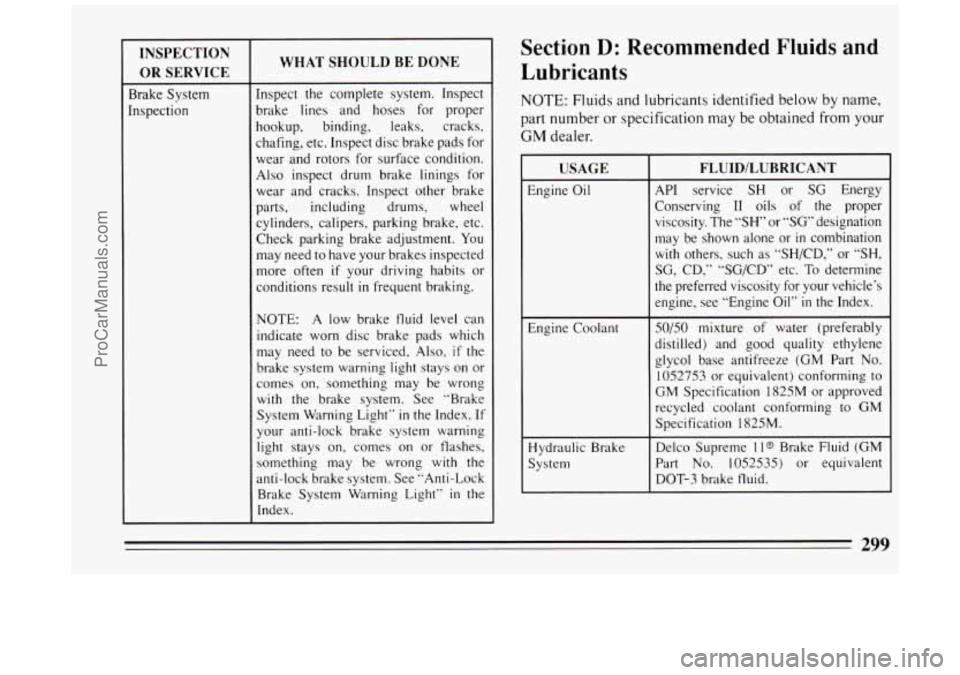
INSPECTION
OR SERVICE
Brake System
[nspection
WHAT SHOULD BE DONE
Inspect the complete system. Inspect
brake
lines and hoses for proper
hookup, binding, leaks, cracks,
chafing, etc. Inspect disc brake pads for
wear and rotors for surface condition.
Also inspect drum brake linings for
wear and cracks. Inspect other brake
parts, including drums, wheel
cylinders, calipers, parking brake, etc.
Check parking brake adjustment. You
may need
to have your brakes inspected
more often if your driving habits or
conditions result
in frequent braking.
NOTE:
A low brake fluid level can
indicate worn disc brake pads which
may need to be serviced, Also,
if the
brake system warning light stays on or
comes
on, something may be wrong
with the brake system. See ”Brake
System Warning Light”
in the Index. If
your anti-lock brake system warning
light stays on, comes on or flashes,
something may
be wrong with the
anti-lock brake system. See “Anti-Lock
Brake System Warning Light”
in the
Index.
Section D: Recommended Fluids and
Lubricants
NOTE: Fluids and lubricants identified below by name,
part number or specification may be obtained from your
GM dealer
I USAGE FLUID/LUBRICANT
API service
SH or SG Energy
Conserving I1 oils
of the proper
viscosity. The
“SH” or “SG” designation
may be shown alone or
in combination
with others, such as “SH/CD,” or
“SH,
SG, CD,” “SG/CD” etc. To determine
the preferred viscosity for your vehicle’s
engine, see “Engine Oil”
in the Index.
S0/50 mixture of water (preferably
distilled) and good quality ethylene
glycol base antifreeze
(GM Part No.
1052753 or equivalent) conforming to
GM Specification 182SM or approved
recycled coolant conforming to
GM
Specification 182SM.
Delco Supreme
1 I@ Brake Fluid (GM
Part
No. 1052535) or equivalent
DOT-3 brake fluid.
~ 299
ProCarManuals.com
Page 302 of 324
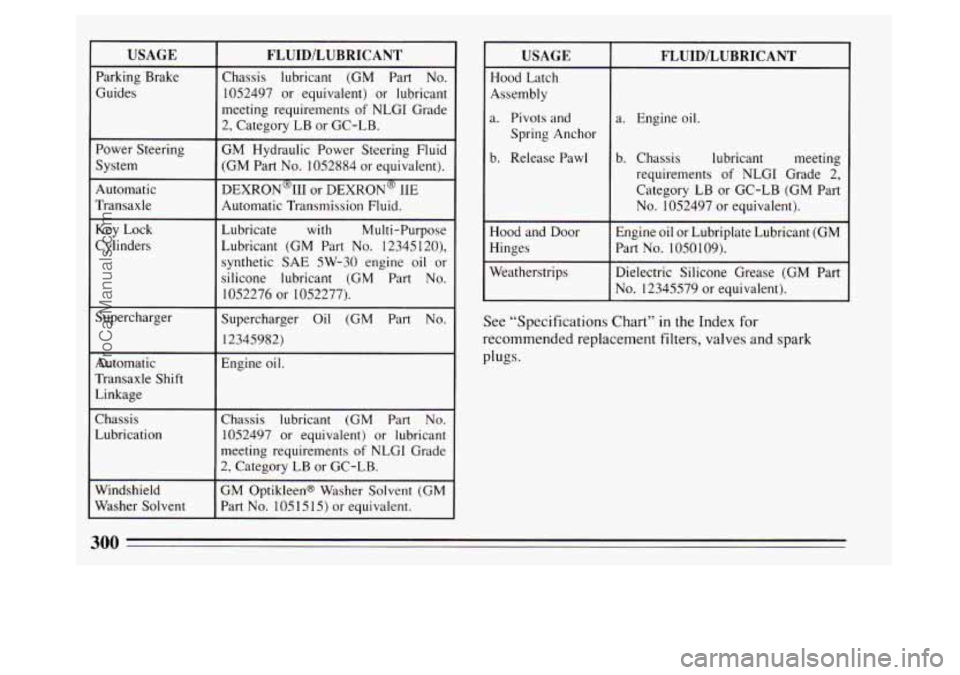
USAGE
Parking Brake
Guides
Power Steering
System
Automatic
Transaxle
Key Lock
Cylinders
Supercharger
Automatic
Transaxle Shift
Linkage
Chassis
Lubrication
Windshield
Washer Solvent
FLUID/LUBRICANT
Chassis lubricant (GM Part No.
1052497 or equivalent) or lubricant
meeting requirements of NLGI Grade
2, Category LB or GC-LB.
GM Hydraulic Power Steering Fluid
(GM Part
No. 1052884 or equivalent).
DEXRON~II or DEXRON~ IIE
Automatic Transmission Fluid.
Lubricate with Multi-Purpose
Lubricant (GM Part
No. 12345120),
synthetic SAE 5W-30 engine
oil or
silicone lubricant (GM Part
No.
1052276 or 1052277).
Supercharger Oil (GM Part
No.
12345982)
Engine oil.
Chassis lubricant (GM Part
No.
1052497 or equivalent) or lubricant
meeting requirements
of NLGI Grade
2, Category LB
or GC-LB.
GM OptikleenB Washer Solvent (GM
Part
No. 105 15 15) or equivalent.
USAGE
Hood Latch
Assembly
a. Pivots and
Spring Anchor
b. Release Pawl
Hood and Door
Hinges
Weatherstrips
FLUID/LUBRICANT
a. Engine oil.
b. Chassis lubricant meeting
requirements of NLGI Grade
2,
Category LB or GC-LB (GM Part
No. 1052497 or equivalent).
Engine oil or Lubriplate Lubricant (GM
Part
No. 1050109).
Dielectric Silicone Grease (GM Part
No. 12345579 or equivalent).
See “Specifications Chart” in the Index for
recommended replacement filters, valves and spark
plugs.
300
ProCarManuals.com